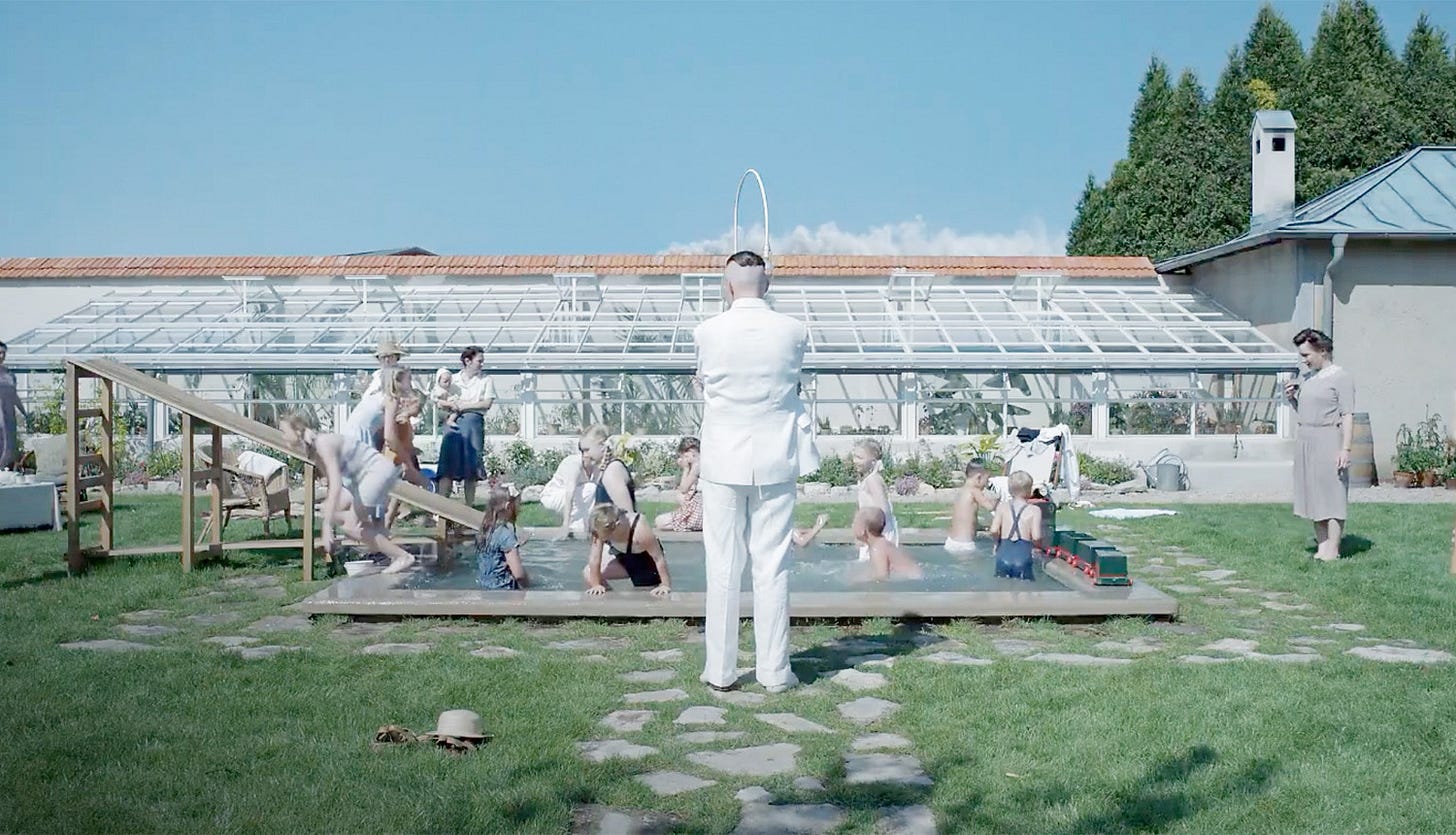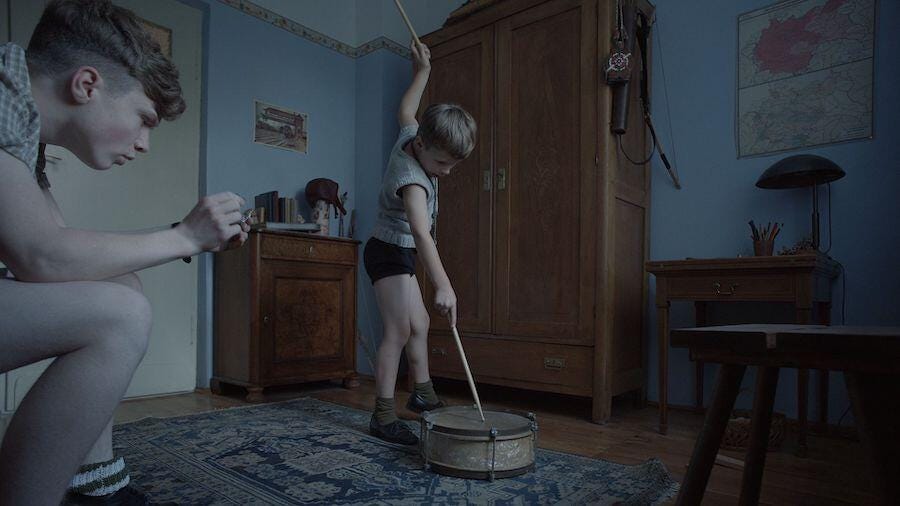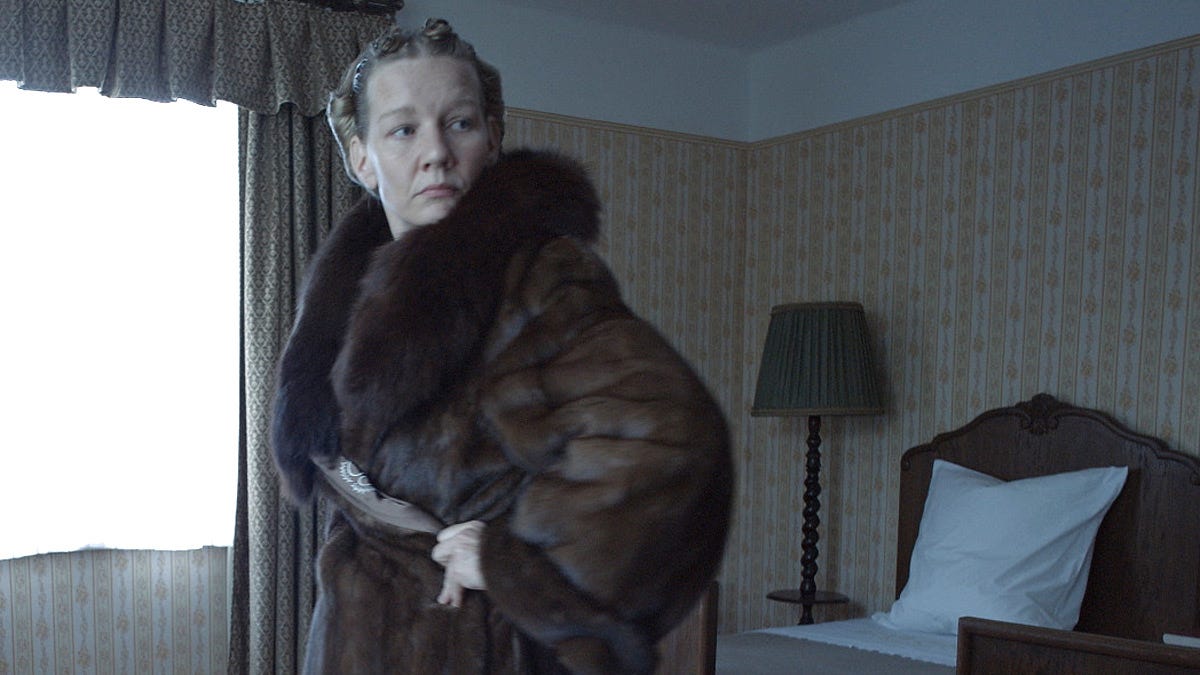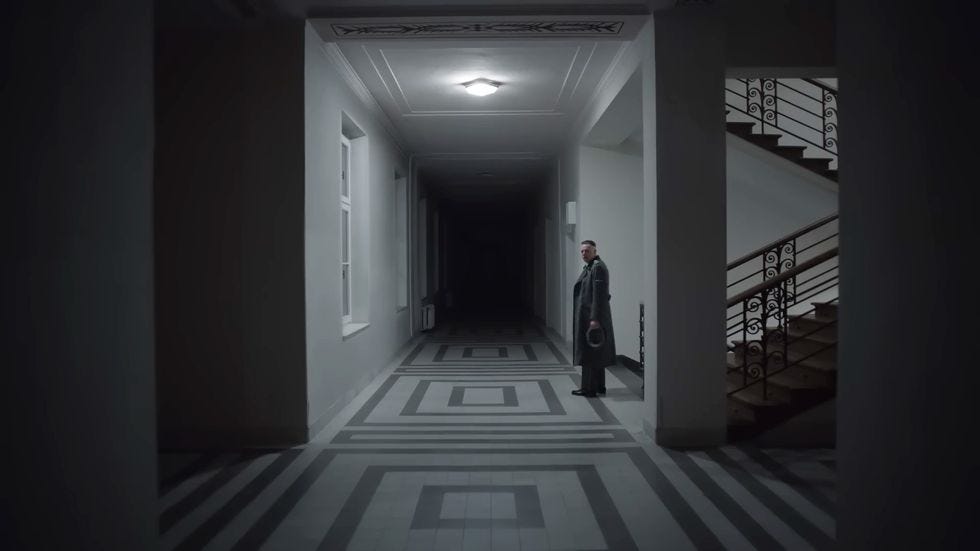Full disclosure: I had every intention of posting a Best Picture round-up of sorts, exploring and writing about the various thematic connections and groupings amongst this year’s ten nominees. As I was drafting that, however, I found myself three pages deep on just The Zone of Interest alone, a movie I haven't yet written about at length, and so I decided to split that off for today’s newsletter. I’ll post my overall look at the nominees next week right on time for Sunday’s ceremony.
The reason I got so deeply in the weeds on The Zone of Interest almost without even realizing it is because not only is it the nominated film that I've seen most recently, and is thus freshest in my mind, but also because it’s far and away the strongest film in a very strong lot. I haven’t been able to shake its hold on me ever since I saw it two weeks ago. It’s a film whose subject matter is of course naturally haunting, but what makes it particularly resonant are the methods that director Jonathan Glazer and his cast and crew have utilized to express some deeply unsettling things about one of history’s darkest periods and, as a result, about humanity as a whole. It’s an incredibly rigorous, formally daring and thematically challenging film to a degree that it is frankly stunning that the movie has been nominated for Best Picture at all, even in a field of ten, let alone for four other awards including Adapted Screenplay. While potentially alienating in that rigor, and in the way that it eschews so many of the things that make even films about troubling subjects more palatable to wide audiences - things like plot, sympathetic characters, or even the baseline use of different camera angles and perspectives to give emotional emphasis and psychological grounding to the dramaturgy - it is nonetheless a once-in-a-generation piece of film craft.
A chilling portrayal of the quotidian day-to-day life of Auschwitz commandant Rudolf Höss (Christian Friedel) and his picture-postcard Aryan family, including wife Hedwig (Sandra Hüller) 1 as they attempt to build a life for themselves in the middle of World War II, the film is set largely at the Höss residence - which just so happens to lie right outside the walls of the infamous death camp. Exterior shots of Hedwig’s sprawling, intricately maintained garden or of the weekend picnics and birthday celebrations are framed with the buildings of Auschwitz peering over the edge of the property wall. Every now and then a billowing plume of smoke will rise straight into the sky or crawl across the distant horizon and we realize with a sickening feeling that as the children splash and play in the pool - under the supervision of a Jewish house staff that attends to their needs with a silent, terrified servility - a new group of innocent victims is either being brought to the camp that lies mere meters away or is being disposed of in the furnaces that we see raging at all hours (there’s a truly sickening scene, indicative of the overall anti-dramatic approach, in which Höss and two visiting salesmen discuss the installation of new, more efficient crematories with the utter dispassion usually reserved for discussing whether to get name-brand or generic snacks for the company break room).

The most-discussed technical aspect of the film has been Johnnie Burn’s sound design, and rightly so in that not only is it disquietingly effective but also key to Grazer’s formal approach to the material. With the exception of a single sequence later on, which is unique for reasons I’ll get into, we never venture inside the camp but rather stay rooted to the area immediately surrounding. This means that Glazer and his crew never show us the horrors beyond the wall, and yet they are ever-present on the soundtrack - occasional shouts, screams, and gunfire punctuate the background mix as the family goes about their daily life, in which they rarely directly acknowledge what they're even living next to (there's a horrifying conversation when Hedwig’s mother visits and, looking at the structures beyond the wall, wonders if the Jewish woman whose house she used to clean is over there - a moment that says so much about the rise of Nazism and it's stoking of not just inherent prejudice but of misplaced class grievance). There is the ever-present low chugging of approaching trains or the churning industrial thrum of the crematorium furnaces. As the film progresses this conceit develops in chillingly effective ways. Later on we get more distinct incidents and even specific dialogue registering within the house; at one point the youngest Höss son even interacts with it while alone in his room. There are moments when we hear a baby crying or a dog barking and, assuming it's the Höss infant or their pet Schnauzer, get sick to our stomachs when they arrive on screen and we realize that what we're hearing is actually coming from over there.

Equally important is the visual approach with which Grazer and DP Lukasz Zal present the proceedings. A ten-camera setup inside the house, operated fully by a remote hub, and the utilization of existing light and microphones concealed within the set design, allowed the cast to perform extended takes not only without interruption, but without the physical presence of a crew at all, often incorporating improv and going until the storage media ran out of space. Referred to by the crew with the shorthand phrase “Big Brother in a Nazi House,” this method allows the actors to exist as their characters, often unaware of where the cameras were or if they were even being filmed, and also facilitates the closest possible approximation of a completely objective perspective that one can get in a piece of fiction filmmaking. The aim here is key to the film’s artistic success in that it allows us to observe these characters’ lives without any kind aesthetic indications as to how or to what degree we should ever be emotionally caught up in what’s happening - this not only reflects the blasé attitude of these people to the atrocities being committed under their watch in their literal backyard, but it also importantly keeps us as an audience at a requisite distance from their interiority as characters.
There are indeed numerous moments in which these people act as recognizably human. An argument over the fact that Höss has been ordered to change posts, and that they must thus vacate the house and property that Hedwig has given such attention to, resonates in its specifics as a conversation familiar to many a married couple (“We built a life here and now we have to move.” “How will we adjust? How will our children adjust?” “Maybe you should go alone and we will have to live separately for a while.” “We’ve done everything asked of us and now the boss is fucking us over”) and then you realize with a heavy weight in your stomach that the root of this family crisis is that they are upset that they have to leave Auschwitz (and that the boss fucking them over is Hitler). Earlier in the film we see Rudolf, on his way to bed, find that his daughter has wandered out of her room and fallen asleep in a hallway, at which point he takes her back to bed, reads to her until she falls back asleep, and then sneaks out carefully so as not to wake her up. A ritual any parent can identify with, and for the briefest second we may tempted to think, “Aww…” until we remember who this man is. Friedel’s countenance is key here as it has an almost cherubic likability that tricks us at times into thinking that the cinematic Höss has anything approaching likability somewhere deep inside, even as we are constantly reminded of how vile he truly is (at one point Grazer lingers with his superiors after he has been dismissed from a meeting so that we can witness one assure the other that Höss will indeed leave enough of the prisoners in his charge alive to staff the labor camps that rely on their forced servitude).
And that’s ultimately indicative of the uncanny balancing act that Glazer pulls off. He allows us to identify ourselves somewhere within these people without ever tempting us to identify with them. While the actors and the script may, at times, portray them necessarily as recognizable human beings, the camera keeps them at a distance while the sound constantly reminds us of the horrors that they are perpetrating. We are never ever allowed to forget who these people are. The aesthetic objectivity is equal opportunity in the way that it refuses to emphasize not only their evil but any scraps of decency they may possess, which ultimately and chillingly suggests the entire spectrum of humanity residing equally within some of the most loathsome people one could choose to center a film around. Any other film would insist on tipping the scales and letting us off the hook by insisting on their evil; here it’s never not evident, but it’s also ever merely present.
The script also balances the more everyday occurrences and discussions with moments that emphasize the characters’ monstrosity without feeling the need of the camera to underline them, such as the aforementioned crematorium sales pitch. Hüller in particular portrays Hedwig as completely removed from and disinterested in confronting or even acknowledging the terrors that have enabled her upward mobility. One of the first things we see Hedwig do is pour through a sack of clothes wheeled over to her house by an emaciated prisoner in tattered rags and proceed to try on a fur coat that still has the owner’s lipstick in the pocket. At one point, angry from an unrelated argument, she scolds one of her Jewish house staff by reminding her that she could have her husband scatter her ashes anytime she wanted.

There are two major instances in which the movie breaks with its own formal construction to different yet incredibly effective ends. The first is a series of brief sequences in which we see one of the Höss’ house staff sneaking out into the middle of the night to plant apples in the surrounding landscape in the hope that those imprisoned will perhaps find them and provide themselves some small nourishment. These scenes are shot in night-vision and are the only diegetic portions of the film that are scored with Mica Levi’s haunting soundscapes. The implication here is not only that the one good deed seen in the film has to be done under such a heavy cover of darkness and in such complete secret that it would be rendered invisible to the human eye, but that this act of human decency is completely and utterly alien to the diegsis of this cinematic world.

The other instance is the film’s ending, and so spoilers incoming I suppose for a movie that’s not really the type you can spoil, though I will say that while I knew this sequence was coming, seeing how it specifically played out in the moment was astounding.
Late in the film, after Höss has been given the orders to return to Auschwitz so that he can step up the extermination efforts, and after a phone call with Hedwig where he has given her the…happy…news while also confessing that at the fancy Nazi gathering he just went to all he could think about were the logistical challenges of gassing everyone in such an open and high-ceilinged room, we see Höss descending a dark staircase. He stops a couple of times, gripped by dry heaves but unable to actually vomit. He reaches a landing and, for reasons we don’t really know, looks down both ends of the connecting hallway. At that point, we cut to what we understand through basic cinematic grammar to be an eyeline match of what he’s looking at, which is a pinpoint of light coming through a door. As that door opens, however, we realize that we are now inside present-day Auschwitz, preserved as a memorial and museum, and we get a sequence in which we see the site’s staff clean and prepare the site’s buildings for that day's visitors.
I found this audacious enough, but what truly made me gasp in the theater is that we then cut back to Höss, standing on the landing, looking down the hallway just as we left him. He gathers himself, puts on his hat, and continues down the stairway into absolute darkness and we cut to credits.
The Zone of Interest is a film that confronts us with people who have so internalized - or perhaps so denied - their own evil, that even the initial furor of hatred that led them to this point has subsided to a low mechanical hum. The atrocities of the Holocaust are a means to an end for them, and have thus become such an accepted facet of their existence that they have become literal background noise, easily avoided and shut out because they are no longer an aberration but simply a necessity to building the world that they now live in. By the end of the film, Höss’ evil has become so concentrated that his body chemistry physically tries to reject it, and yet his soul is so corroded that he easily swallows it back and keeps going. Even when the extent of his evil, the historical impact of his deeds, has become so unfathomable that it breaks the continuum of time and results in this metaphysical bridge where he can seemingly peer into a future where his life will be forever memorialized as the blight on humanity that it is, he simply turns away and keeps going.
Much has been made of how this film fits within the current geopolitical context, about how it is a film concerned with the degree to which we can shut out the horror of the world in order to live our lives and, by doing so, allow these horrors to perpetuate. And there is of course something to that - Glazer himself has said that this is a film not only about the Holocaust but about the world today. But Glazer isn’t depicting the lives of everyday German citizens - his main character is a trusted member of Hitler’s military apparatus and one of the chief architects of the Final Solution. I think there’s something deeper and even more resonant to it all. When we talk about humanity, we like to frame it as a concept within the more beneficent aspects of our character; what this film confronts us with is the reality that we have to reckon with the other side of that as well, because to think of that side as something other, of something inhuman, is to deny its roots and allow it to continue in perpetuity. These people are monsters, but they are also human - and that’s key to what the film is ultimately saying about how and why these campaigns of monstrosity are able to be enacted. This makes it not only a film that can be about the then, or the here and now, but about the whole course of human history. Whether we want to face that or whether we would prefer that those truths fade to a dim background noise.
-cs
Both actors have expressed their previous disinterest in ever portraying Nazis, and yet each was won over to this film after meeting with Glazer and learning about his intended approach to and intentions with the material.





